PLANNERS MULL USING A-BOMB ON JAPAN
Pentagon, Washington, D.C. · May 31, 1945
On this date in 1945 a special group met in the Pentagon to search for an alternative to dropping the atomic bomb on Japan. The group had been called into existence by the new American president, Harry S. Truman. Neither Truman nor anyone else in the room knew what kind of damage the still-untested weapon might do. What the planners thought they knew, however, especially as the ferocity of Japanese resistance on Okinawa became clear, was this: the tally of U.S. and Japanese dead would boggle the mind. As it turned out, at the end of the Okinawa campaign (April 1 to June 21, 1945) the dead numbered 12,500 Americans and 110,000 Japanese; the loss in tanks, ships (36 sunk and 368 damaged), aircraft, and other materiel was so severe three-quarters of the way through the campaign that political and military leaders alike were increasingly wary of the endgame costs. The invasion of the Japanese home islands, set to begin in November 1945 and end the next April, was estimated to cost as many as one million Allied lives, to say nothing of other losses on both sides. Six weeks later, on July 16, a huge predawn explosion in the New Mexico desert settled the issue. “We have discovered the most terrible bomb in the history of the world,” Truman wrote in his diary on July 25. Three days later, the Japanese cabinet rejected a final demand for unconditional surrender, the Potsdam Declaration (issued July 26, 1945), despite an explicit warning that the only alternative would be “prompt and utter destruction.” Truman told Soviet dictator Joseph Stalin two days earlier that the U.S. was prepared to use the doomsday weapon “very soon unless Japan surrenders.” But the president was concerned about where to use it. Neither Tokyo, or what was left of it, nor the ancient Japanese capital of Kyoto was an appropriate target for nuclear destruction. Truman ordered the Secretary of War was to find targets with heavy concentrations of military personnel and to issue warning statements asking the Japanese to surrender to save lives. “I’m sure they will not do that,” he wrote in his private papers, “but we will have given them the chance.” A short list of suitable targets was devised. Within two weeks Hiroshima and Nagasaki lay in ruins, not to be the last if the country didn’t surrender, Truman promised Japanese leaders. The most destructive bomb in history killed 120,000 people, brought World War II to an end, and marked the beginning of the atomic age.
[amazon_carousel widget_type=”ASINList” width=”600″ height=”200″ title=”Recommended Reading” market_place=”US” shuffle_products=”False” show_border=”False” asin=”1591143160,0552778508,052173536X,0870134035,0060742852,1579125387,0316831247,1570033544,0691128189,080785607X” /]
Hiroshima, August 1945
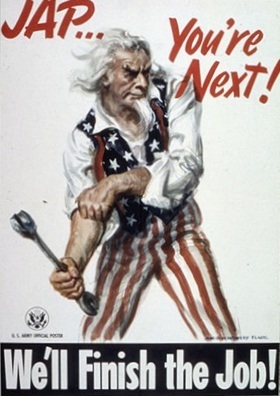 | 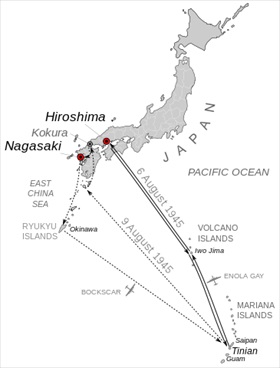 |
Left: U.S. Army poster prepares the American public for the invasion of Japan after ending war with Germany and Italy.
![]()
Right: Mission map for the atomic bombings of Hiroshima and Nagasaki, August 6 (Enola Gay) and August 9, 1945 (Bockscar). Kokura, on the northern tip of the southern island of Kyūshū, appears on this map because it was the original target for August 9. Weather obscured visibility over Kokura, so Nagasaki, also on Kyūshū, was chosen instead.
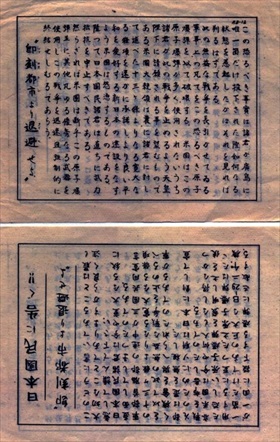 | 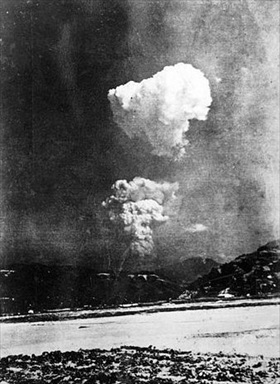 |
Left: Front and back of leaflets urging Japan’s quick surrender were dropped over the country by the 509th Composite Group, a group that comprised B-29 bombers and transport aircraft. The 509th was a component of the U.S. Manhattan Project under the command of Lt. Col. Paul W. Tibbets, Jr. At 2:45 a.m. on August 6, 1945, the Enola Gay departed Tinian in the Mariana Islands for Hiroshima with Tibbets at the controls. Tinian was approximately 2,000 miles away from Japan, so it took six hours to reach Hiroshima. The atomic bomb, codenamed “Little Boy,” was dropped over the city at 8:15 local time. Tibbets reported that Hiroshima was covered with a tall mushroom cloud after the bomb was dropped.
![]()
Right: Atomic cloud over Hiroshima, August 6, 1945, 8:45 a.m. This photograph was found in 2013 at Honkawa Elementary School (now a peace museum) and is believed to have been taken 6 miles east of ground zero about 30 minutes after detonation.
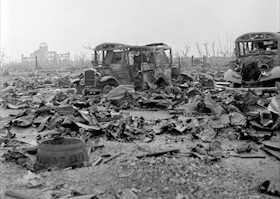 | 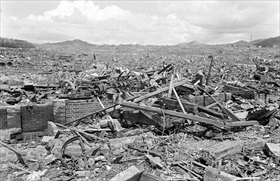 |
Left: Hiroshima, September 1945. In the background the Genbaku (A-Bomb) Dome, the only structure left standing near ground zero. The building, at the time serving as the Hiroshima Prefectural Industrial Promotion Hall, later became a part of the Hiroshima Peace Memorial Park, which was designated a UNESCO World Heritage Site in 1996.
![]()
Right: Hiroshima, September 1945. Japanese officials determined that 69 percent of Hiroshima’s buildings were destroyed and another 6–7 percent were damaged. Out of some 70,000–80,000 people killed, 20,000 were soldiers, a ratio of military to civilian dead President Truman had urged (the higher the better) in his directive to Secretary of War Henry L. Simpson.
Hiroshima: The Aftermath
![]()

 History buffs, there is good news! The Daily Chronicles of World War II is now available as an ebook for $4.99 on Amazon.com. Containing a year’s worth of dated entries from this website, the ebook brings the story of this tumultuous era to life in a compelling, authoritative, and succinct manner. Featuring inventive navigation aids, the ebook enables readers to instantly move forward or backward by month and date to different dated entries. Simple and elegant! Click
History buffs, there is good news! The Daily Chronicles of World War II is now available as an ebook for $4.99 on Amazon.com. Containing a year’s worth of dated entries from this website, the ebook brings the story of this tumultuous era to life in a compelling, authoritative, and succinct manner. Featuring inventive navigation aids, the ebook enables readers to instantly move forward or backward by month and date to different dated entries. Simple and elegant! Click 











